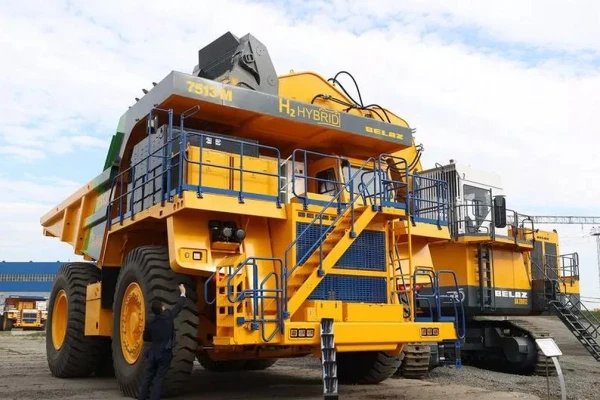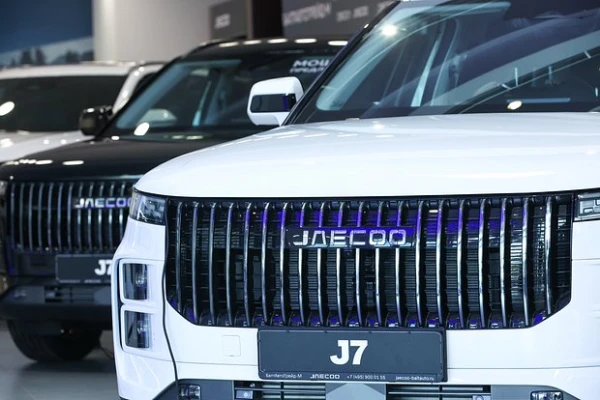
Nvidia CEO Jensen Huang stated that China may surpass the U.S. in the artificial intelligence race, but the U.S. is still leading.
"China will win the artificial intelligence race," said Jensen Huang, CEO of Nvidia, an American graphics processing unit manufacturer, at the Future of AI summit in early November, as reported by 24tv.ua.
This statement shook the world, as it sounded like a warning that the U.S. risks losing its leadership in advanced technologies. Huang argued that China could surpass the U.S. due to lower energy costs and fewer regulatory restrictions for the AI industry. He pointed out that the West, particularly the U.S., "holds itself back with cynicism" and excessive rules, while Beijing actively supports its tech champions – even by subsidizing energy resources for AI data centers.
However, after the interview was published, Huang quickly softened his position. A few hours later, an explanation from the CEO appeared on Nvidia's official page on X (formerly Twitter): "As I have said for a long time, China is literally nanoseconds behind America in AI. It is extremely important for America to win – to do this, we need to race ahead and attract developers from around the world."
Thus, the Nvidia leader noted that the U.S. still retains an advantage, but it should act quickly and unite global talents.
Earlier, speaking at a developers' conference in Washington, Huang stated directly: "We want America to win this AI race, without any doubt... But we also need to be present in China to attract their developers. The policy that causes America to lose half of the world's AI specialists will not benefit us in the long run."
These words refer to U.S. export restrictions – in Huang's opinion, overly strict bans will only cut American companies off from a vast base of Chinese talent and market, which could ultimately harm the U.S. itself more.
AI Race: A New "Cold War" of Technologies?
The struggle between the U.S. and China for supremacy in artificial intelligence is often compared to the arms race of the Cold War. But this time, "the weapons are algorithms instead of atoms," as aptly noted by Wall Street Journal commentators.
Indeed, the stakes are incredibly high: whoever establishes leadership in AI will set the rules of the game in the global economy, military affairs, and even in matters of values and freedoms.
China approaches this systematically. Beijing deliberately directs resources, subsidies, and political will towards the accelerated implementation of artificial intelligence, and private corporations are forced to act in line with state strategy.
In contrast, the U.S. AI development ecosystem is more decentralized and market-driven: the main driver is the private sector and open science, while the government often lacks the levers to coordinate the efforts of businesses and universities at the national level, writes the Atlantic Council. On one hand, this creates unprecedented innovation dynamics (it is in the U.S. that giants like OpenAI or Google with their advanced models emerged), on the other hand, it makes the American system less cohesive in the face of China's state machine.
The winner of this race will determine global standards and norms in technology. Whether the values of "authoritarian efficiency" or "democratic dynamism" will dominate largely depends on whose artificial intelligence model becomes predominant.
It is no coincidence that Washington has repeatedly raised the issue of ethical norms for AI use: as early as 2021, the Pentagon released guidelines for "responsible AI" in defense, and more than 50 countries supported a declaration on the military use of artificial intelligence and autonomy. Thus, the U.S. aims to lead not only in technological but also in moral-legal leadership, ensuring that future "smart" weapons serve security rather than become an uncontrollable threat.
Defense Dimension: AI at the Service of the Military
The rivalry in the military sphere is particularly fierce. Both Washington and Beijing understand that artificial intelligence can fundamentally change the nature of armed conflicts. This is not only about cybersecurity or intelligence analysis – it involves autonomous drones, robotic platforms, combat decision support systems, and AI-controlled precision weapons.
U.S. military strategists note the lessons from the war in Ukraine, where relatively simple drones and robotic systems have demonstrated high effectiveness.
In 2023, the Pentagon launched a billion-dollar initiative called Replicator – an accelerated program aimed at creating thousands of unmanned drones and maritime robots with elements of artificial intelligence. The goal is to compensate for China's potential numerical advantage in military technology by creating "swarms" of autonomous systems capable of operating without direct human control and effectively deterring the adversary, for example, in the event of a threat to Taiwan.
China, for its part, is also not standing still.
Beijing is actively investing in unmanned aerial vehicles, underwater drones, tracking and targeting systems based on AI. Additionally, in recent years, China has showcased samples of weapons with elements of artificial intelligence at military parades and exhibitions – from robotic tanks to kamikaze drones.
Although the exact details of Chinese military programs are classified, it is known that AI integration is part of the official strategy of the People's Liberation Army to "intellectualize" the military by 2030. In fact, it involves using algorithms to enhance the speed and efficiency of command, intelligence, logistics, and weapon application.
This raises concerns in Washington – there, hawks warn that transferring modern American chips or AI technologies to Beijing could accelerate China's militarization of artificial intelligence. One congressman even equated the sale of top AI chips to China with "supplying weapon-grade uranium to Iran." In other words, Nvidia chips, in the eyes of some American politicians, are not just a commodity but a strategic resource that affects the military balance of power.
What is the Essence of the AI Race and How is the West Responding?
Anatoly Khrapchinsky, a Ukrainian expert on military technologies and deputy director of a company producing electronic warfare (EW) systems, answered this question for 24 Kanal.
According to Khrapchinsky, it is important to understand the context of Huang's statement about China surpassing the U.S. He says this not because the United States is already losing, but because he raises the priority of the industry within the U.S. and stimulates the government and the market to invest more actively in computing infrastructure, energy, data centers, and defense AI programs. These are strategic actions on his part, conditionally: "To maintain technological leadership, we must invest now," Khrapchinsky asserts.
As for Nvidia itself, today it controls not just chips but the platform, meaning both hardware (GPU) and software tools (CUDA, AI libraries), and entire deployment chains for computing.
"This gives it global influence. But there are weak points, a strong dependence on production in Taiwan (TSMC), U.S. export restrictions on China, and the rapid growth of competitors, including its own giant clients who are creating their own chips. If the market gradually shifts from 'giant models in giant data centers' to millions of small autonomous models at the edge (drones, vehicles, combat systems), Nvidia's monopoly could be undermined," the expert adds.
"Returning to AI, it is important to soberly understand that there is currently no real 'intelligence' in machines. What we call AI is large statistical models that learn from data sets and make predictions about the likely next action or response. This is algorithmic optimization, not thinking," the specialist noted.
Khrapchinsky gives a simple example – a ballistic calculator for air defense. It receives data on the speed, course, and altitude of the target, takes into account physics, wind, sensor inaccuracies, and calculates the interception point.
"It does not 'understand' the missile or the space, but computes according to given rules. Modern AI models do the same; they are given data and a method of processing, they find patterns and make predictions, but do not comprehend the content, intentions, or context," the expert explains. "Therefore, we have not created 'intellect.' We have created very powerful forecasting tools that imitate intelligence."
Nevertheless, these tools already provide a huge military, economic, and political advantage to those who control them, the interlocutor believes.
"Therefore, the struggle for AI infrastructure is about who will have faster analysis, more accurate targeting, more effective logistics, and better intelligent decision support. It is not about 'robots taking over the world.' That is why Huang and his company are pressing the topic of 'AI and China' – not to declare defeat, but to accelerate industrial mobilization. And that is why Nvidia is actively investing in projects such as collaboration with Nokia, where the companies are developing AI platforms for future 6G telecom networks. This is the formation of a new platform, intelligent networks that combine computing, communication, and artificial intelligence, creating a foundation for next-generation defense and civilian systems," the expert emphasized.
Two Strategies: The U.S. and China
In the AI race, hardware resources play a huge role – primarily powerful semiconductor chips for training models and processing data. The U.S. is currently the undisputed leader in the design and production of the most advanced AI chips – Nvidia controls over 90% of this market.
However, China is the main manufacturing hub for global electronics and is striving for technological independence. Realizing that computing power directly translates into AI progress, the Trump administration intensified export controls to limit Beijing's access to advanced chips.
In October and November 2025, Washington banned the supply of the latest Nvidia Blackwell series graphics processors to China – the very ones that are the "brains" of modern artificial intelligence systems. Trump publicly stated that only American companies should have access to powerful AI chips to maintain the U.S. advantage. At the same time, exceptions were made for allies such as South Korea – for example, Seoul received a batch of 260,000 Blackwell chips for its own needs.
As for Beijing, according to Trump, it will have to settle for simplified versions of processors, and only if China changes its attitude: currently, the relationship is such that Nvidia itself does not even apply for export licenses – Chinese authorities clearly indicate that the company is "not welcome" there.
The U.S. strategy is clear – to hold on to "trump card" technologies so that the competitor cannot leap ahead. However, Jensen Huang and many other industry representatives warn that such an approach may backfire. If China cannot purchase the best American GPUs, it will be forced to invest even more resources in developing its own chips. In the short term, the restrictions will slow down Chinese AI projects, but at the same time will stimulate Beijing towards self-sufficiency.
Huang explains: deprived of access to Nvidia, Chinese tech giants will start massively purchasing local alternatives, investing in their chip manufacturers and accelerating local R&D and innovations. Moreover, gradually, Chinese companies will reduce their dependence on Nvidia's proprietary software, facilitating the transition to their own AI ecosystems. In other words, the West's refusal to sell technologies is pushing China towards import substitution, and consequently – to potentially greater technological independence in the future.
Washington understands these risks but bets that the technological time gap will still work in favor of the U.S. Notably, alongside the strict U.S. bans, China has also imposed its own restrictions: since the fall of 2023, Beijing has banned the use of foreign (i.e., American) Nvidia chips in key state data centers and institutions. Both superpowers seem to mirror each other, trying to secure their supply chains and not "feed" each other's economies.
As a result, by the end of 2025, Nvidia's market share in China has dropped to nearly zero. Huang calls this a huge blow, as about one-fifth of Nvidia's revenue previously came from China. For the company itself, this means billion-dollar losses, and for the U.S., a reduction in profits that could have been invested in new developments on American soil. Therefore, the head of Nvidia is sounding the alarm: in his opinion, America must win not through bans but through innovations.
Who Will Reach the Finish Line First, If There Is One?
The question of who will win the AI race remains open. Despite Jensen Huang's bold words, it is worth noting that the U.S. still retains several important advantages. Among them are a creative startup ecosystem, leading research universities, access to allies, and global capital markets. American tech giants set trends in generative AI, and brain drain from around the world provides the U.S. with a constant influx of talented engineers.
On the other hand, China has its own trump cards: vast data sets, fewer restrictions on their use, government coordination of efforts, and a political decision to become a leader by 2030. Beijing is already ahead of Washington in the number of AI patents and scientific publications, and most importantly – it is not lagging in the practical implementation of AI, from factories to the battlefield. As noted by the Wall Street Journal, both the U.S. and China in this race are equally driven not only by the desire for progress but also by the fear of falling behind. Therefore, both countries are now pushing the gas pedal to the limit.
Fortunately, so far, the competition is primarily taking place in the economic and scientific realm, rather than on the real battlefield. But if the AI race is indeed comparable in significance to the nuclear confrontation of the 20th century, its outcome will determine the world order for generations to come.
Winning this marathon means not only gaining a technological advantage but also imposing one's standards, values, and rules – from data privacy principles to the permissibility of autonomous weapons. The American strategy now combines two approaches: "containment and advancement."
To contain means to slow down the opponent's progress through export controls and sanctions; to advance means to invest in one's breakthrough research, mobilize allies and global developers, and form beneficial coalitions. China, on the other hand, bets on "scale and integration": mobilizing the entire national potential – from state funding to millions of engineers – and embedding AI into the economy and military as broadly as possible.
Which of these approaches will prove more successful will be seen in the next few years. Perhaps the race will not have a clear finish line, as artificial intelligence is not a static goal but a constantly evolving field. However, it is already clear that neither Washington nor Beijing intends to slow down. As Jensen Huang said, China is indeed "a few nanoseconds behind," but this lag can turn into an advantage if America stops or fears to take risks.
Therefore, the U.S. is trying to win by racing ahead, while China is ready to seize every opportunity as soon as the West stumbles. The race continues, and at stake is technological leadership in the world and overall security in the age of artificial intelligence.















Leave a comment